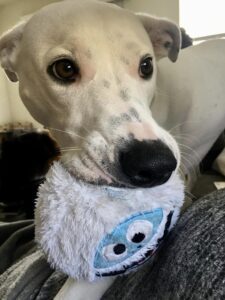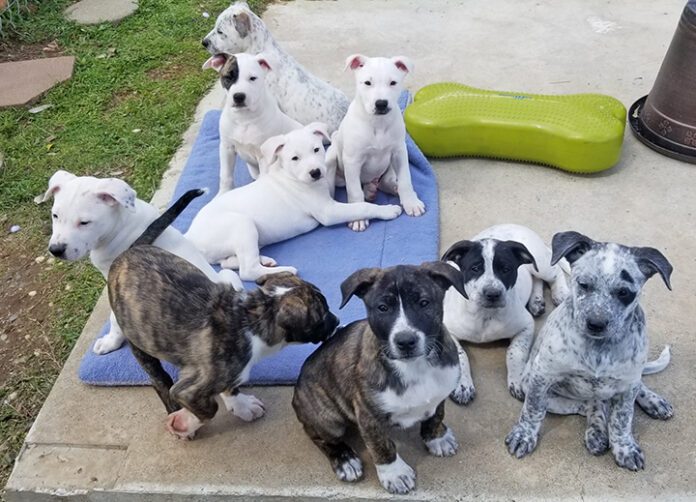As I write this, I am visualizing strength and a return to health for Buster, a dog who just turned three years old, and whom I met for the first time when he was about five weeks old. He was one of a litter of nine puppies that my friend Leonora and I co-fostered for our local shelter at the very outset of the COVID pandemic in early 2020. Getting all the pups adoptive homes was made more complicated by the fact that the shelter, like most others, closed its doors to the public at that time, and instead, required that potential adopters make appointments to come and meet specific puppies that they were interested in. (Normally, when the shelter has a litter of puppies for adoption, people can take the whole bunch into the “get acquainted” room at the shelter to try to decide which one they have an affinity for – or which one likes them best!) This slowed the adoptions – which meant that Leonora and I had puppies staying with us for longer than usual – which meant that we couldn’t help but get more and more attached to the puppies who took the longest to get adopted.
Leonora fell particularly hard for Buster. When we met the couple who ultimately adopted him, we were happy that he had found such a good home, even though Leonora was sad to see him go; she had been this close to keeping him herself. He was a particularly sweet, funny, and confident pup with adorable markings on his face. We later discovered that his new owners enrolled him in puppy kindergarten classes (and later, doggie daycare) at The Canine Connection, the premium boarding, daycare, and training facility in our area. Hurray! We’d see his photo pop up in The Canine Connection’s photo albums from time to time; it was always a thrill to see how big and handsome he had become.
When Buster was about 18 months old, I ended up meeting his owners as they were having dinner in a restaurant in town where my sister was a cook. Not long after that, we got together with all of our dogs and I showed them a couple of my favorite trails in the Oroville Wildlife Area where I walk with my dogs. We became friends on Facebook and “liked” each other’s dog photos.
A local danger?
About two weeks ago, I aw a heart-stopping post on Facebook by one of Buster’s owners. Megan wrote, “It has been one helluva week and one that I don’t want to ever repeat.” She went on to say that Buster had vomited a number of times at daycare. She took him to the vet the next day and the vet felt some masses in his abdomen. He ended up undergoing emergency surgery to remove the suspected blockage, but things went from bad to worse.
The vet found a tumor, but also lots of bowel in very bad shape, including some perforations. The vet removed some of the bowel, but did not remove the tumor, which had grown all around the bowel; she had suspicions about the tumor that proved correct: it was loaded with an organism called Pythium insidiosum. This is an oomycete (pronounced oh-uh-MY-seat) – an organism that looks and acts like a fungus but is more closely related to algae. It’s found in stagnant water, and can cause the growth of tumors if ingested. The problem is, unless every bit of the tumor and the oomycetes is removed, the organism can quickly recur. The vet did her best to patch Buster back together again, and started him on a course of strong anti-fungal drugs that stand the best chance of knocking the P. insidiosum back.

As I write this, things are not looking promising for Buster. His owners and veterinarian are trying desperately to get him into the veterinary clinic at the University of California, Davis, vet school, hoping that they could perform the complicated surgery to remove the Pythium-infested tumor – and hoping the anti-fungal drugs can knock out the Pythium. But it’s a long shot; “pythiosis” (as an infection with this organism is called) has a notoriously poor survival rate in dogs when it’s as advanced as Buster’s case is.
I was (and am) aghast at Buster’s diagnosis. I had never heard of pythiosis before – and when I looked it up, everything I read said it was most common in the states that border the Gulf of Mexico, where it is known colloquially as “swamp cancer.” But the more I researched the topic, the more reports I found of cases in dogs within an hour’s drive of where I live – and Buster’s vet is one of my vets! She suspected pythiosis before a biopsy came back because she recognized the appearance of his intestinal tumor; she had previously seen a case like his a few years ago.
If Buster was exposed to this organism locally – well, shoot, his owners take him to some of the same places where I take my dogs for walks at least once a week. Is this horrible organism in our local wetlands now?
I asked Jennifer Bailey, one of our veterinary contributors, to write an article about pythiosis for WDJ; she had never heard of pythiosis before, either, but she knocked out an article in record time and we posted it immediately. There is some speculation that this organism is expanding its range due to climate change, but since the treatment for this infection is most successful the faster it is recognized and treated, I wanted to spread the word about it as quickly as possible. And while none of my dogs has any sign of an infection, I’m going to look into getting titer tests for the two younger dogs, who have been walking in the same wetlands as Buster.
If you take your dog anywhere that there is stagnant water – near wetlands, ponds, or swamps – please read Dr. Bailey’s article on pythiosis, so you can recognize any early signs of an infection. It’s a particular concern in duck dogs whose owners hunt in flooded rice fields. There may be something in the agricultural practices of rice-growing that is favorable to the organism’s growth; a form that attacks the skin, causing non-healing sores, affects many humans who work in rice fields in places with a tropical, subtropical, or temperate climate such as Thailand and Malyasia.






This is indeed frightening! I am an ecologist that specializes in identifying wetlands and advising regarding compliance for transportation projects and a rescue dog adopter. I had not heard of this until a few weeks ago. There is a dog in a local rescue that was just diagnosed with the skin form. They did a big fund raiser and are taking her to a University in Florida to try to save her. We live in Iowa. I currently have 3 large dogs and part of my “backyard” is a poorly drained seasonal wetland. I am very concerned about doing normal outdoor stuff with my dogs this summer as many of our favorite places are wet.
How far north has this been found?
Wisconsin!!
Thanks for this, Nancy: I read the article from Dr. Bailey, and found it most disturbing…now your story of Buster concerns me even more, especially for the readers of my column up in your area. I’m wondering if I could contact Dr. Bailey about doing a guest post on pythiosis in my column, which runs every other Thursday in the Chico Enterprise. Thoughts??
For local comment, consider contacting Dr. Colleen Prather at Look Ahead Veterinary Hospital. She’s Buster’s vet, and has seen previous local cases.
I live in northern Indiana. Lots of swamps here. A lady I met on my local bike trail lost her beloved Sheltie to a fungal or bacterial organism known for growing in the swamp mud. The black slippery dirt you find in the woods here. Unfortunately they lived right next door to a creek that just has enough water in it to keep the land muddy. I learned a valuable lesson from her. I no longer allow my dog to go into areas like that.
Does anyone know if this has been found in Oregon yet? We frequently walk our dog at a state wildlife mgt that has a lot of wetlands during the wet part of the year. We try to keep from drinking or wading there due to other concerns about the water quality there we are not 100% successful. We are wondering if we should ask our vet about doing a titer test. How long can a dog be infected with this before showing symptoms?
I would check with PAVLAB, the laboratory that seems to be specializing in this and related organisms, mentioned in the sidebar at the end of our feature: https://qa.whole-dog-journal.com/health/pythiosis-in-dogs/. My local vet quoted me $205 for the pythium titer test (plus a $55 office visit) but I’m looking into whether this would be far less at PAVLAB.
Are there any updates on Buster? I have been thinking of him often.
Thank you for asking! He is hanging in there! When he initially presented to the veterinarian, his intestine had been blocked by pythium-caused masses. He had a large section of his intestine removed at that time, but the veterinarian couldn’t remove all of the mass; it was too extensive. Instead, they started him on the multi-drug anti-fungal treatment – and waited to see if they could get him eating and gaining weight again. Further surgery to remove the mass has been ruled out for now, as it’s still large and in an area that can’t be easily resected. His owner reports that he’s holding his own, slowly gaining a bit of weight — and that follow-up abdominal ultrasounds show that the mass is shrinking. It’s still not a great prognosis overall, but he’s doing well at the moment!
I am devastated to report that Buster had a crisis the night that I responded to your inquiry. Despite immediate emergency veterinary care and one-on-one veterinary nursing overnight, he succumbed to the disease midday on March 18. My thoughts are with his dedicated owners, who did everything they could for him.